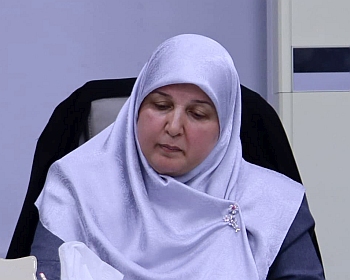جرت يوم الخميس الموافق 20/ 12/ 2018 على قاعة المرحوم الدكتور سالم عبدالحميد المناقشة العلنية لرسالة طالبة الماجستير زينب عباس عبد الجبار الكبيسي الموسومة :
تقييم فعالية Quercetin المضادة للأكسدة والالتهابات ونمو الخلايا السرطانية
حيث تألفت لجنة المناقشة من التدريسيين الأفاضل :
أ.د .نهلة عبدالرضا البكري رئيسا
أ.د . غسان محمد سليمان عضوا
م.د . مها عبدالنبي غثوان عضوا
ا.م.د. هنادي سالم عبدالصاحب عضوا ومشرفا
تعد الفلافونيدات من المركبات الوقائية والعلاجية المستقبلية ضد العديد من الأمراض المختلفة، ويوجد الكيورستين في العديد من الفواكه والخضروات، مثل البروكلي والبصل الأصفر والتفاح. أظهر الكيورستين فعالية في تقليل جزيئات البادئة للالتهاب في خارج الجسم، ودوره في الفعالية المضادة للسرطان. ومع ذلك، لا تزال الآليات النوعية والمتخصصة وراء هذا النوع من الإصابات غير مفهومة بشكل كامل.
أجريت هذه الدراسة لهدفين رئيسين: أولا، لتقييم فعالية الكيورستين على تثبيط الجزيئات البادئة للالتهاب والجهد التأكسدي المحفز بواسطة السكريد المتعدد الشحمي (LPS) داخل الجسم الحي وكذلك تثبيط تعبير الجزيئات البادئة للالتهاب proinflammatory واظهار الفعالية المضادة للأكسدة في داخل جسم الكائن الحي In vivo. وثانيا، أهمية الكيورستين كعامل مضاد للورم في خط خلايا سرطان الثدي MCF-7. شملت الدراسة داخل الجسم معاملة الفئران بالــ LPS (المستخلص من بكتريا السالمونيلا Salmonella enteriditis ) بتركيز 50 ملغم/ كغم ، (تحت البريتون intraperitoneally) لمدة 90 دقيقة بعد التجريع بالكيورستين لمدة 5 أيام بتركيز 5 و 10 ملغم/كغم. تم استعمال 60 من الفأراً ذكراً وتقسيمها على 6 مجموعات. وشملت التجارب المختبرية تأثير الكيورستين والـ LPS في الكبد والطحال في الفئران الذكور، تم قياس النشاط الإنزيمي عن طريق تقدير تركيز مالونالديهايد (MDA)، الكلوتاثيون (GSH)، والكاتليز (CAT).
أما في الطحال، فقد تم قياس تركيز الحركيات الخلوية التي شملت IL-6 ، IL-1 beta ، IL-33 و TNF-α. وشملت التجارب خارج جسم الكائن الحي اختبار MTT، اختبار Clonogenicity و التصبيغ DAPI + Suforhadamine 101 لتقييم موت الخلايا المبرمج لخلايا سرطان الثدي. أظهرت نتائج مؤشر وزن الأعضاء (الكبد والطحال) وجود فروق معنوية (p<0.05) في كل من مجموعتي الكيورستين 5 و 10 ملغم/كغم بمقارنة مع مجموعات السيطرة الموجبة (LPS)، كما وجدت اختلافات معنوية بين مجموعتي السيطرة الموجبة والسالبة، في حين لم تكن هناك اي فروق معنوية في مجموعة السيطرة الموجبة بين تركيزي الكيورستين المستعملة في الدراسة. أظهرت نتائج مستويات الكلوتاثيون فروقاً معنوية (p <0.05) بين السيطرة الموجبة وبين المجاميع المعاملة الأخرى. كذلك لوحظت زيادة معنوية في المجاميع المعاملة بالكيورستين سواء لوحده أم ممزوج مع LPS. فضلا عن ذلك فقد ، أظهرت النتائج وجود فروق معنوية بين مجموعتي السيطرة الموجبة والسالبة، في حين أن المعاملة بالكيورستين وحدها لم تجد فيها أي فروقاً معنوية مقارنة بالسيطرة السالبة. كشفت مستويات المالونديهايد malonaldehyde فروق معنوية بين المجاميع المعاملة بالكيورستين مقارنة مجموعتي السيطرة الموجبة والسالبة. بالإضافة إلى ذلك، أظهرت النتائج فروق معنوية في مستوى الكاتليز في المجموعات المعالجة بالكيورستين مقارنة بمجموعة السيطرة الموجبة. كانت هناك أيضا فروق معنوية في السيطرة الموجبة مقارنة بالمجموعة المعاملة بالكيورستين 5 و 10 ملغم ، في حين لم توجد اي فروق معنوية في مجموعة السيطرة الموجبة مقارنة بالسيطرة السالبة.
ومن المثير للاهتمام أن نتائج مستويات IL-6 و IL-1β و IL-33 أظهرت فروقاً معنوية (p<0.05) في المجموعات المعالجة بالكيورستين مقارنة مع مجموعة السيطرة الموجبة بطريقة تعتمد على الجرعة. أيضا وجدت هذه الدراسة فروقًا معنوية في السيطرة الموجبة مقارنة بالسيطرة السالبة، كذلك وجدت فروق معنوية ضمن مجموعة السيطرة الموجبة اعتمادًا على تركيز الكيورستين. بالإضافة إلى ذلك، أظهرت مستويات TNF-α فروقا معنوية (p<0.05) في المجموعات المعالجة بـ 5 و 10 ملغ من الكيورستين مقارنة بمجموعة السيطرة الموجبة؛ ومع ذلك لم يلاحظ أي اختلافات معنوية في مجموعة السيطرة الموجبة. تم فحص التأثير السمي للكيورستين على نمو خط الخلايا السرطانية MCF-7 بعد التعرض للكيورستين لمدة 24 ساعة باستعمال تراكيز 12.5 و 25 و 50 و 100 و 200 ميكروغرام/مل من الكيورستين. أظهرت النتائج وجود فروق معنوية في التركيز (100 ، 200) ميكروغرام/ ل مقارنة بمجموعة السيطرة (p<0.001).
كانت هناك أيضا فروق معنوية بين التركيز 200 ميكروغرام/مل مع التراكيز الأخرى (12، 25، 25)، وكذلك بين تركيز 100 ميكروغرام/مل مع التركيز 25 ميكروغرام/مل عند مستوى احتمال p<0.05 وعند p<0.01 بتركيز 12.5 ميكروغرام/مل. وكشفت نتائج هذه الدراسة عن التأثير التثبيطي للكيورستين في نمو خط الخلايا السرطانية MCF-7 والتي تمت معاملتها بـ 5 ميكروغرام/مل من الكيورستين مقارنة بمجموعة السيطرة. أظهرت نتائج فعالية ازالة او كسح الجذور الحرة للكيورستين، والمعروف باسم اختبار DPPH، وجود فرق معنوي (p<0.05) عند التركيز 25 ملغم.مل-1 مقارنة مع 100 ملغم.مل-1. أيضا، أظهر التركيز نفسه فروقاً معنوية بتركيز 200 ملغم.مل-1 ولكن على مستوى الاحتمالية p<0.01، في حين أن تركيز 600 ملغم.مل-1 أظهر فروقاً معنوية عند مستوى الاحتمالية p<0.001 مقارنة بتركيز 25 ملغم.مل-1. وأظهر اختبار تشكيل المستعمرات أن الكيورستين بتركيز 5 و 10 ميكرومتر قد ثبط معنويا تكوين مستعمرات خلايا سرطان الثدي MCF-7 (p<0.01) مقارنة بمجموعة السيطرة السالبة.
لقد بينت نتائج الدراسة الحالية إلى ان حقن الكيورستين ولمدة قصيرة قادر على تثبيط الالتهاب والأكسدة الناجم عن العدوى وان نموذج الفئران تشير إلى دور الفائدة المحتملة للكيورستين ضد سرطان الثدي.
The M.Sc. Thesis discussion of student ( Zainab Abbas AbdulJabar Al-Kubaiasi ) from department of Biology
On Thursday, the 20th of December 2018, at the hall of the late Dr.Salim Abdulhameed,the M.Sc. thesis discussion of student (Zainab Abbas AbdulJabar Al-Kubaiasi) from department of Biology entitled(Evaluation of the effectiveness of quercetin in anti-oxidant, inflammation and cancer cell growth)has been discussed
The discussion committee
Prof.Dr.Nahla AbdulRidha Al-Bakri Head
Prof.Dr.Ghasan Mohammed Sulaiman member
Dr.lecturer.Maha Abdulnabi Ghathwan member
Asst.prof.Dr.Hanadi Salim AbdulSahib supervisor member
The Abstract
Flavonoids are considered as promising preventive and therapeutic plant agents against different diseases. Quercetin is one of the most flavonoids found in many fruits and vegetables, such as broccoli, yellow onions, and apples. Quercetin has been shown to reduce proinflammatory molecule expression in vitro and, as well as, exert anti-cancer effects through the inhibition of several intracellular pathways. However, the specific mechanisms behind this type of injury are still not completely understood. This study was undertaken with two main aims. Firstly, to evaluate the ability of quercetin to inhibit lipopolysaccharide (LPS) induced lethal toxicity and proinflammatory molecule and antioxidant expression in vivo. Secondly, the importance of the quercetin as an anti-tumor agent in breast cancer cell line MCF-7. Mice receiving LPS (Salmonella enteriditisLPS, 50 mg/kg, intraperitoneally) for 90 min after received quercetin for 5 days at dose of 5 and 10 mg kg-1. Sixty male mice were used and divided into 6 groups. In vitro experiments included the effect of quercetin and LPS on the liver and spleen of male mice. In the liver, the enzyme activity was measured by estimating the concentration of malonealdehyde (MDA), glutathione (GSH), and catalase (CAT). While in the spleen, the concentration of cytokines was measured including IL-6, IL-1 beta, IL-33 and TNF-α. In vitro experiments included MTT assay, clonogenicity test and DAPI + Suforhadamine 101 to assess breast cancer cells apoptosis. The results of organs weight index (liver and spleen) exhibited significant differences (p<0.05) in both 5 and 10 mg kg-1 quercetin groups compared to the positive control groups (LPS), and also significant differences were seen between positive and negative control, while there were no significant differences in the positive control group between two studied concentrations of quercetin. The results of glutathione levels showed significant differences (p<0.05) between positive control and other treatments groups. A significant increase was observed due to the treatment of quercetin either individually or in combination with LPS. Moreover, the results showed significant differences between the positive and negative control groups, while quercetin treatment alone did not found any significant differences in comparison to negative control. Levels of malonaldehyde revealed highly significant differences between quercetin treatment groups compared to positive and negative control groups. Additionally, the results showed significant differences in catalase level of in groups treated with quercetin compared to positive control group. There were also significant differences in the positive control group treated with quercetin 5 and 10 mg, while no significant effect was detected in the positive control group in comparison to negative control. Interestingly, the results of IL-6, IL-1β and IL-33 levels showed significant differences (p<0.05) in quercetin-treated groups compared with positive control group in dose-dependent manner. Furthermore, this study found significant differences in positive control in comparison to negative control, and significant differences were found within the positive control group depending on the concentration of quercetin. Additionally, TNF-α levels showed significant differences (p<0.05) in the groups treated with 5 and 10 mg of quercetin compared to positive control group; however no significant differences were observed in positive group. The cytotoxic effect of quercetin on MCF-7 cancer cell line was examined after the exposure to quercetin for 24 hours using concentrations of 12.5, 25, 50, 100 and 200 μg/ml of quercetin. The results showed significant differences at concentration (100, 200) μg / ml compared to control group (p<0.001). There were also significant differences between 200 μg/ml with other concentrations (12, 25, 25), and also significant differences were seen between the concentration of 100 μg/ml with 25 μg/ml at the probability level of p<0.05 and at p<0.01 with concentration of 12.5 μg/ml. The findings of this study revealed the inhibition effect quercetin on the growth of the MCF7 cancer cell line that treated with 5 μg ml-1 of quercetin in comparison to control group. The results of the free radical scavenging activity test for quercetin, known as the DPPH test, showed a significant difference (p<0.05) at concentration of 25 mg. ml-1 compared to 100 mg. ml-1. Also, the same concentration showed significant differences compared to the concentration of 200 mg. ml-1, but at the probability level p<0.01, while the concentration 600 mg. ml-1 showed significant differences at the probability level of p <0.001 in comparison to the concentration of 25 mg. ml-1. Colony formation test showed that quercetin at 5 and 10 μM of concentrations significantly inhibited the colony formation of MCF-7 breast cancer cells (p<0.01) compared to negative control group
The data implies evidence quercetin injection for short time was capable of inhibiting inflammation and oxidative stress caused by infection and mouse model suggest a possible benefit role of quercetin in breast cancer













